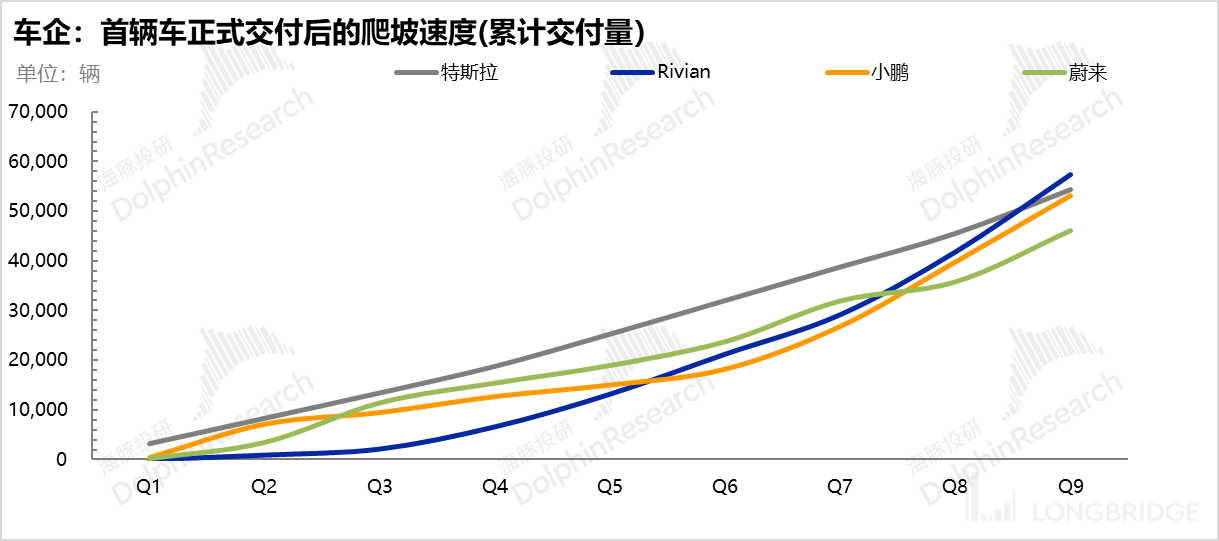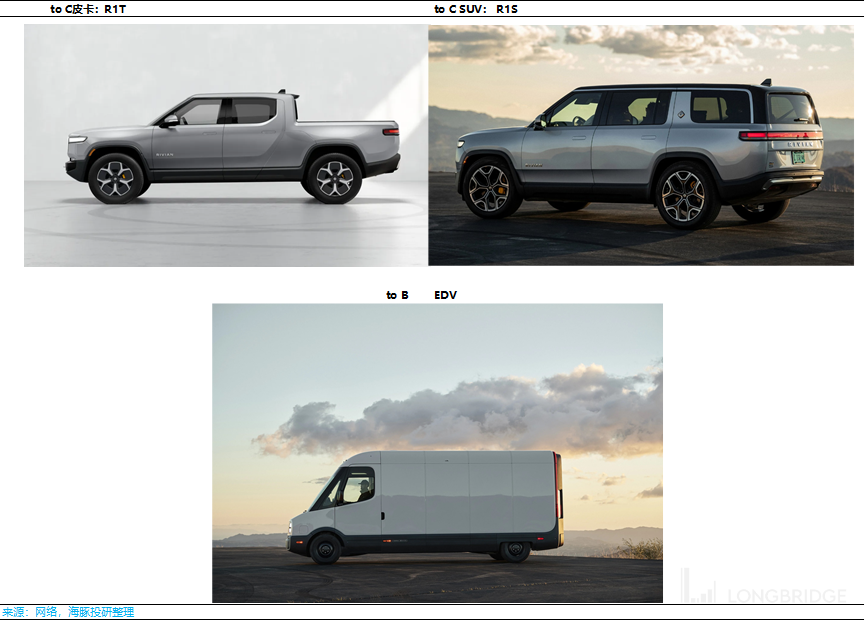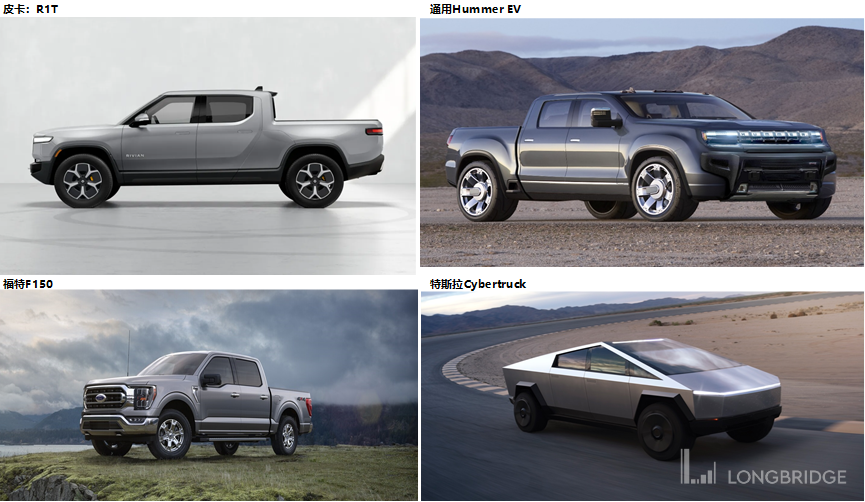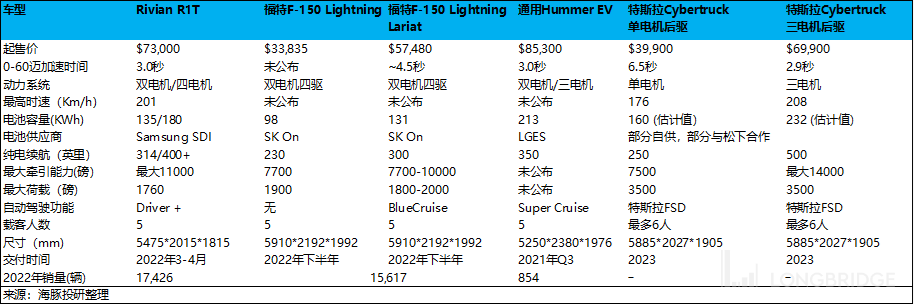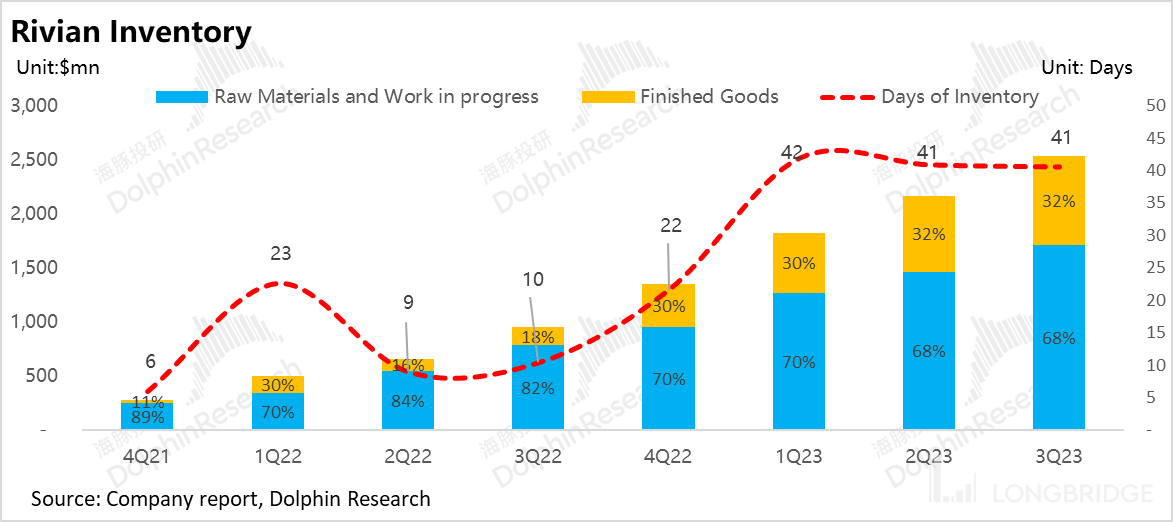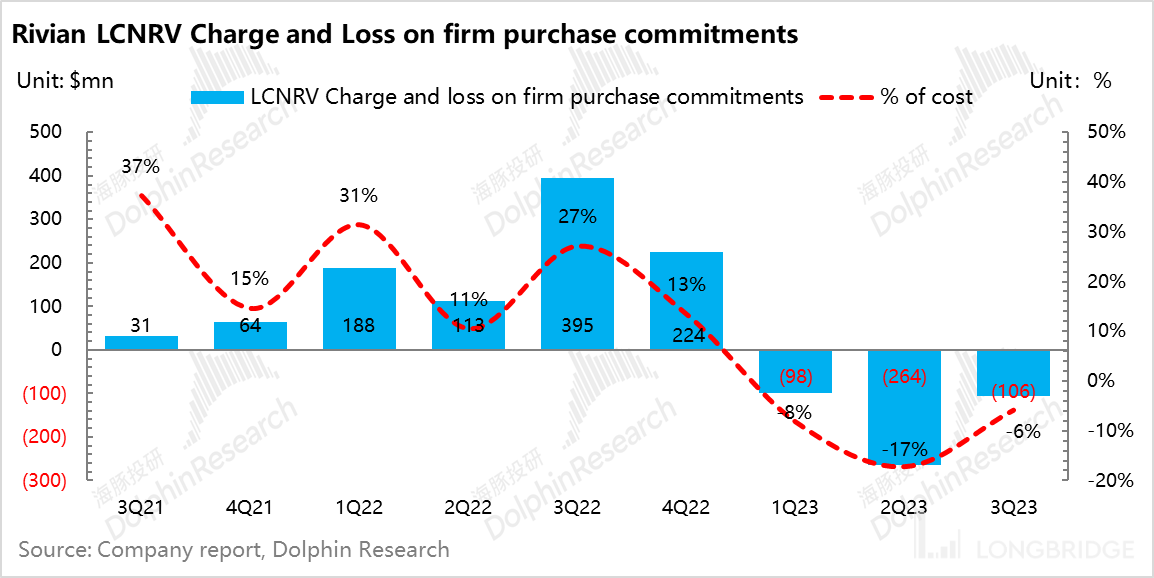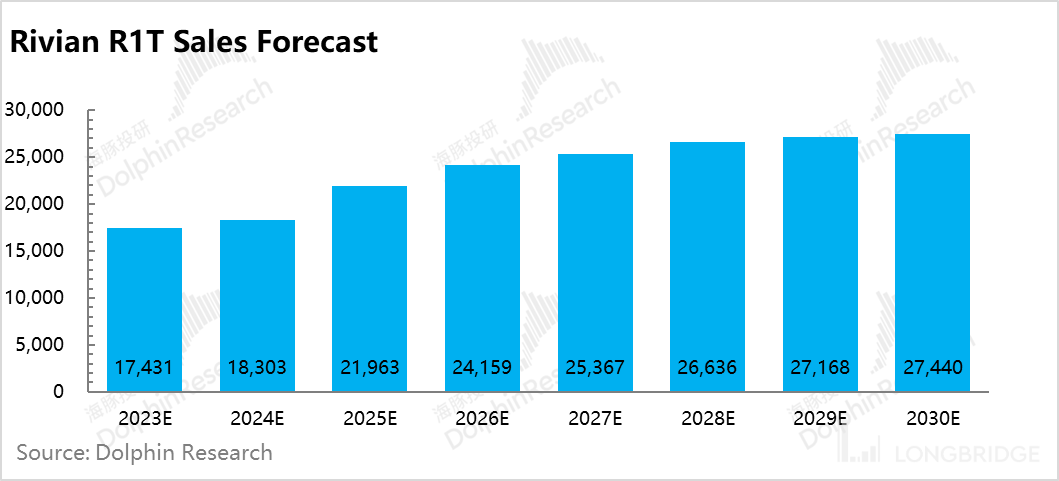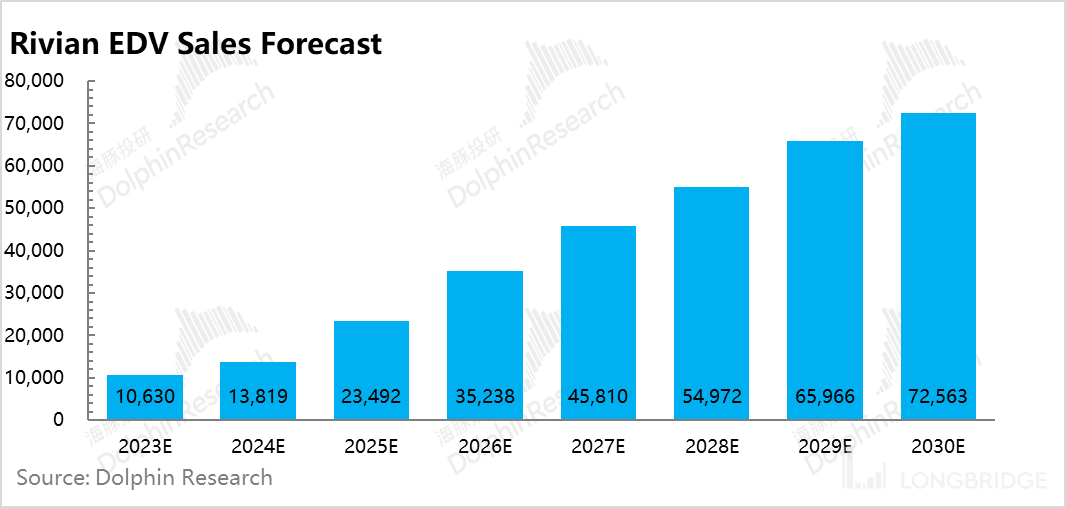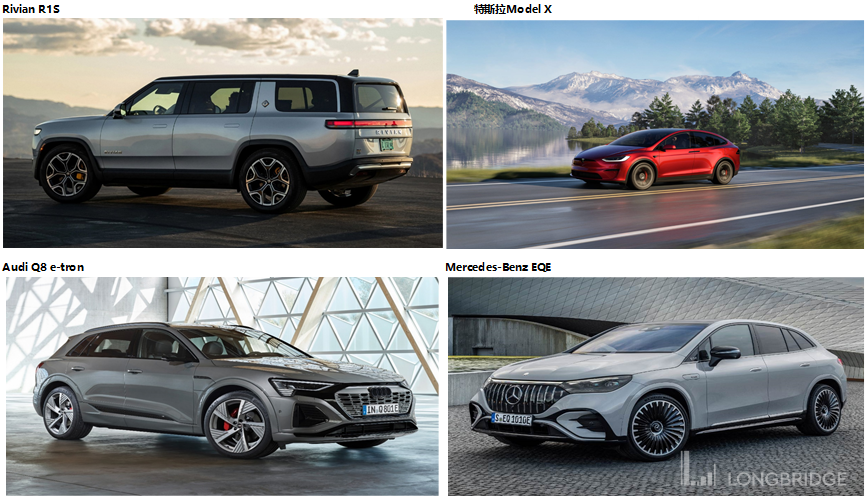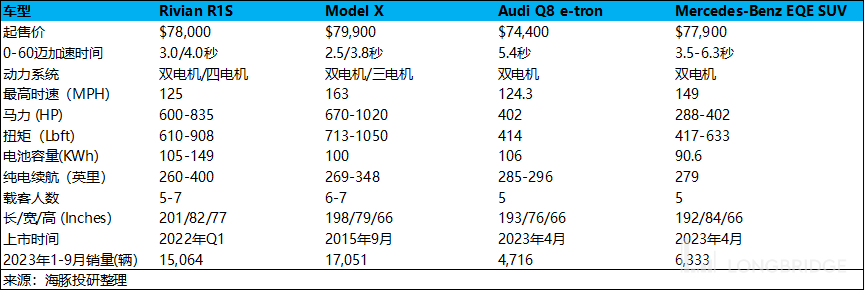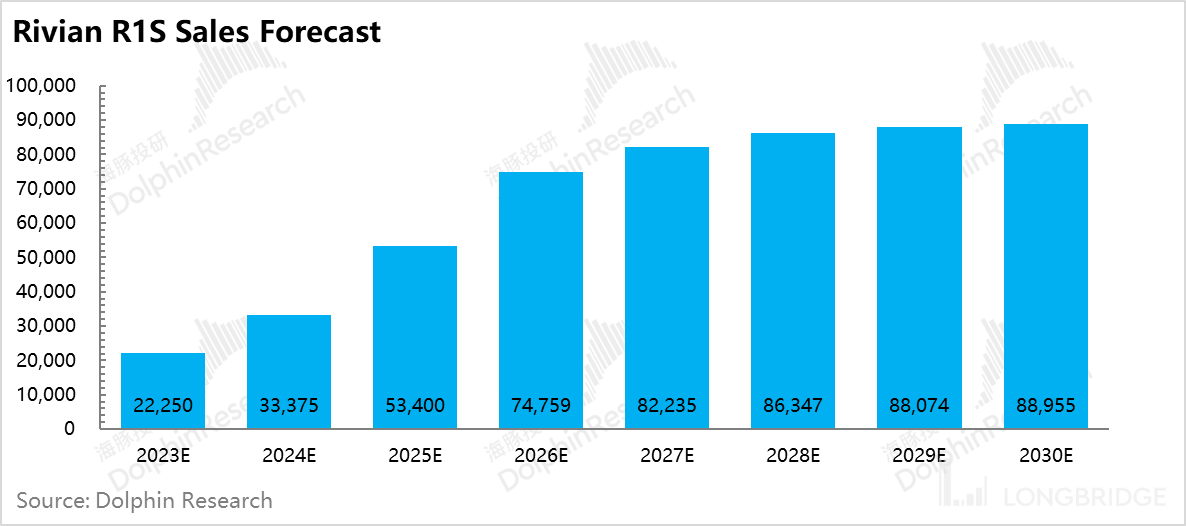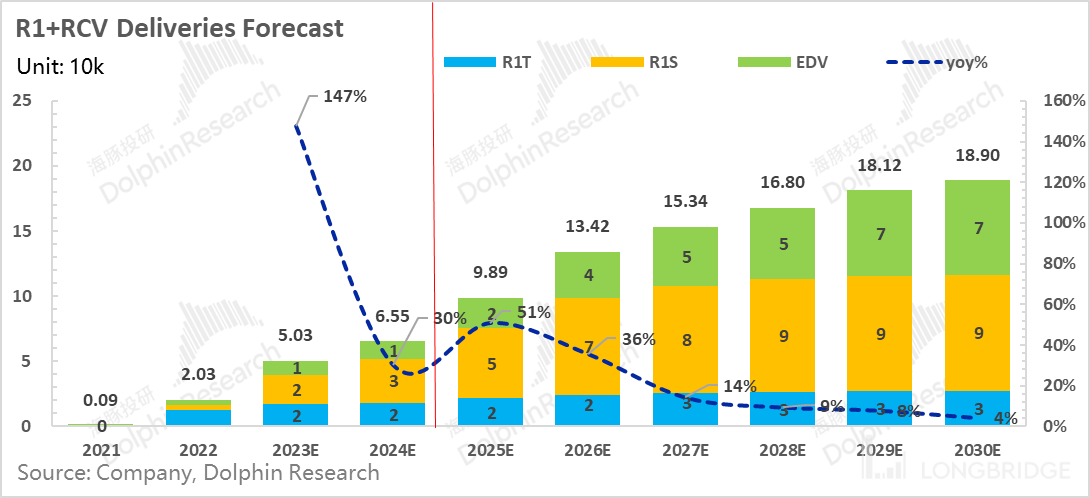Rivian Automotive: "Injured before the battle", the Tesla killer becomes the one being killed?
Rivian Automotive, a rising star in the American automotive industry, is known as the "Tesla killer". It once raised a record-breaking $11.9 billion in its IPO in 2021.
With the support of major investors such as Amazon, the Middle East, and Pershing Square, its market capitalization peaked at $150 billion and then dropped to $15 billion. In just a year and a half, it vividly demonstrated the concept of a "capacity inferno" with a reverse tenfold stock performance.
As the bubble burst, the three major new forces in the American automotive industry, Rivian Automotive, Lucid, and Fisker, were severely impacted by the capacity constraints. Dolphin Research will now focus on Rivian Automotive and consider it as a promising asset in the field of new energy stocks in the US market.
In the previous analysis, Dolphin Research focused on the following key questions:
1) What is the reason behind the continuous decline in Rivian Automotive's stock price? Can this issue be resolved?
2) How much incremental space is there for the company's current products?
The detailed content is as follows:
I. Why should we pay attention to Rivian Automotive?
When studying the US new energy vehicle market ("Tesla: How Far is Musk's Trillion-Dollar Empire Dream?"), Dolphin Research had two relatively clear observations:
a) After the Democratic government shifted towards supporting the local supply chain of the new energy vehicle industry, the US new energy vehicle industry chain may become relatively sound by 2026. This presents an opportunity for a hopeful new energy vehicle company in this chain.
b) To establish a presence in the US new energy vehicle market, it is highly likely that a company needs to offer large-sized, heavy-duty pickup trucks or SUV models that can tow trailers.
c) Among the three new forces, Rivian Automotive is the one that has made some progress in deliveries and scaling. If one of the American new forces can survive in the market, the probability of Rivian Automotive being that company may be higher.

2. What cards does Rivian Automotive have?
First of all, although Rivian Automotive is a new force in the US automotive industry, it is much older than the new forces in China. It was established in 2009, about 5 years later than Tesla. It also focuses on developing its own electric powertrain (excluding battery cells) and has popularized the "skateboard chassis". Its product style is similar to the electric version of Land Rover, and its pricing is even higher than Tesla Model X. It also has excellent financing capabilities and has attracted investments from various investors such as Amazon, Cox Automotive, Ford, and Abdul.
However, its founder is not as "crazy" as Musk, and the company does not have the same level of international influence and connections as Tesla, especially in China.
But after so many years of accumulation, Rivian Automotive still has some cards in hand. Let me briefly summarize them for you:
1) One factory, three vehicles; targeting both consumers and businesses
Rivian Automotive currently has very simple assets: two platforms, three electric vehicles, and one factory.
Factory: Located in Normal, Illinois, it was acquired from Mitsubishi Motors. The planned production capacity by the end of 2023 is 150,000 vehicles, but the actual production is expected to be around 54,000 vehicles, indicating that the capacity utilization rate is not sufficient.
Vehicle models: Two consumer-oriented vehicles and one business-oriented vehicle. The R1 vehicle platform is used for the two consumer-oriented vehicles. The first-generation pickup truck, R1T, is a truck with cargo space and towing capability. The first-generation SUV, R1S, has a design reminiscent of Land Rover. The business-oriented vehicle is built on the RCV platform, and currently only one electric delivery van named EDV (Electric Delivery Van) is being produced.

III. From being praised by many to becoming a reverse ten-bagger stock
After the launch of only three models, Rivian Automotive Automotive Automotive Automotive Automotive still managed to attract a lot of attention and support from various investors. The reasons behind this can be traced back to its 2-row 5-seat Rivian Automotive Automotive Automotive Automotive Automotive R1T all-electric pickup truck. But before we talk about the R1T, let's take a look at the pickup truck market in the United States.
Pickup trucks were born in the early 20th century in the United States. Due to its vast land and sparse population, vehicles became a necessary means of transportation, emphasizing functionality (high towing capacity and large cargo capacity) and luxury comfort.
And pickup trucks basically meet these requirements: they have a large payload capacity and can carry a lot of cargo; they can also accommodate the whole family and tow trailers; in this case, they can still carry passengers.

In the 2022 U.S. car sales rankings, the most popular three models, Ford F-Series, Chevrolet Silverado/Sierra, and Dodge RAM, are all pickup trucks, and pickup trucks account for half of the top 10 sales.

Obviously, such vehicles have very high power requirements, which is why the penetration rate of electric pickup trucks is extremely low: in 2022, the annual sales of pickup trucks reached 2.73 million units, but only 34,000 electric pickup trucks were sold, with a penetration rate of only 1.2%.
Currently, there are not many electric pickup trucks available on the market. Only three models, Rivian Automotive Automotive Automotive Automotive Automotive R1T, Ford F-Series, and GMC Hummer, are on sale. Upcoming models include the Chevrolet Silverado electric pickup truck, Dodge RAM 1500 REV, and Tesla Cybertruck.

As a new player, Rivian Automotive Automotive Automotive Automotive Automotive naturally received a lot of attention and support from investors for being one of the first to launch an electric pickup truck in the United States. However, for a new player without a solid foundation, this model has two fatal bugs:
1) Too Expensive:
However, compared to other pickup trucks on the market that have already announced their specifications and prices, although the Rivian R1T is one of the earliest electric pickup trucks available on the market, its pricing is almost double that of similar fuel-powered vehicles. Currently, in terms of cost-effectiveness, it is also not as good as the upcoming Cybertruck, which is transitioning from futures to spot market:
a. Price: The Rivian R1T is priced lower than the General Motors Hummer EV in the electric pickup truck segment, but higher than the Ford F-150 and Tesla Cybertruck.
b. Towing and Payload: The main functions of a pickup truck, the R1T has lower towing and payload capacities compared to the three-motor version of the Tesla Cybertruck, but higher than the Ford F-150.
c. Battery Capacity and Range: Lower than the three-motor version of the Tesla Cybertruck, but higher than the Ford F-150.
d. Autonomous Driving: Although both Tesla and Rivian have developed their own autonomous driving technologies, Tesla has already established a leading position in autonomous driving with its self-developed chips, algorithms, and computing power centers. Rivian's autonomous driving technology cannot be compared to Tesla's.

2) "Difficult Production"
The issue of high pricing is not a big problem since it is not targeting the entire American market, and there will always be people willing to try it out. Therefore, when the new vehicle started pre-sales at the end of 2020, the number of orders far exceeded the production capacity.
However, the real challenge lies in being able to mass-produce and deliver vehicles within the fluctuating prices of raw materials over the past two years:
In 2022, the original delivery target was set at 50,000 vehicles, but due to various challenges, the target was halved. As a result, Rivian only produced 24,000 vehicles and found itself in a "production hell". One moment there is a semiconductor shortage, and the next moment there is a problem with the connection of core components. Various issues seem to be emerging one after another.
And this difficult process is the process of Rivian Automotive Automotive Automotive Automotive Automotive becoming a tenfold stock in the capital market.
So the next question naturally is, has the capacity problem been resolved? Is there still demand?
4. Have they emerged from the capacity purgatory?
Let's start with the intuitive impression: With a designed annual capacity of 150,000 vehicles, only 54,000 vehicles were produced in the whole year of 2023. It seems that the problem has not been solved. Looking at the latest marginal changes, the production volume in the third quarter was almost at its peak, but it was only about 15,000 vehicles, corresponding to a total of 60,000 vehicles for the whole year. It is still quite challenging to squeeze out more production.
Delivery time: In terms of ordering time, Rivian Automotive Automotive Automotive Automotive Automotive currently has two car purchase modes: 1) Choose a car you like and place a normal order (with the option to choose preferred configurations), but the delivery time is about 4 months; 2) Buy a ready-made inventory car that has been cancelled by someone else (with no option to change configurations), and the delivery time is only 1-6 weeks.
On the other hand, Tesla's delivery time is generally within 4 weeks for inventory cars. Under normal circumstances, a four-month delivery time makes it too easy for competitors to snatch customers, especially considering that Rivian Automotive Automotive Automotive Automotive Automotive's orders have always been cancellable (with a full refund of the deposit upon cancellation). The second car purchase option itself is also a consequence of slow production capacity - customers can't wait and many people cancel their orders.
It can be seen that, in the first car purchase mode, which is the same as other car companies, the four-month delivery time is a clear bottleneck in production capacity.
So, has there been any improvement from 2022 to 2023? Let's analyze it from the perspective of inventory and inventory impairment:
Inventory turnover: In Rivian Automotive Automotive Automotive Automotive Automotive's previous inventory structure, raw materials and work-in-progress accounted for about 80%-90% of the inventory. The company had a large amount of backlogged raw materials that could not be turned into finished products.
Looking at the inventory turnover days (note: calculated in a similar way to Tesla's disclosure, using new car ending inventory/quarterly deliveries), when Rivian Automotive Automotive Automotive Automotive Automotive was in its "capacity hell" in 2022, the finished goods inventory could only meet about 10 days of quarterly deliveries.
By 2023, this situation has clearly improved. Finished goods account for about 32% of the inventory, and the finished goods inventory can meet about 41 days of quarterly deliveries, which is about 4 times higher than the worst period.

Inventory Impairment Reversal: Another important indicator to pay attention to in inventory is inventory impairment and loss on purchase commitments (LCNRV), which is a direct reflection of the change in "production capacity hell".
Inventory impairment losses generally have several sources:
Raw materials and components purchased in the past, such as batteries, may have a significant change in market value compared to the original purchase price;
Purchase contracts signed with suppliers may result in contract losses due to production volume not meeting standards;
Sales price reduction losses caused by outdated inventory.
In fact, this matter is basically the same as the problems Dolphin Research has been tracking in the product iteration process of Xiaopeng, Li Auto, and NIO, and there is nothing new about it. Generally, when problems occur, this loss provision will be directly included in the cost of selling cars, affecting the gross profit margin of the car sales business for the current period.
But the main problem is that Rivian Automotive's production capacity hell frontline has dragged on for too long. Previously, due to the inability to produce cars for a long time, a large amount of impairment was made, resulting in a "bleeding" state of the gross profit margin.
With the improvement of delivery capability, as well as the reduction of sales costs due to increased production volume and cost reduction through technology, Rivian Automotive has slowly reversed the large amount of cumulative losses previously recognized.
The balance of LCNRV losses has been significantly reduced compared to 2022, and a total of 468 million has been reversed this year, directly raising the gross profit margin from -151% in the fourth quarter of last year to -36% in the third quarter of this year. The gross loss per vehicle has also been reduced from -124,000 USD in the fourth quarter of last year to -31,000 USD in the third quarter of this year.

Additional Information:
a) According to the investigation of the Normal factory, the management stated that although key components have not yet reached the required level, they have improved a lot. In 2022, Rivian Automotive lost 21 days of production due to a shortage of key components, but so far this year, Rivian Automotive has not experienced a shortage of key components. The production rate this year is more stable, and production stoppages have not been used to solve component shortages.
b) At the same time, Rivian Automotive's vertical integration capabilities have to some extent alleviated the supply chain tension. The company has internally developed a new motor called Enduro, which complements the previously outsourced Bosch four motors.
In 2022, the shortage of power semiconductors has affected Bosch's ability to provide four motors, thereby suppressing Rivian Automotive's production. However, now the company can accelerate production and launch dual-motor four-wheel drive models with Enduro, while continuing to expand the production of four-motor four-wheel drive models, thereby increasing production.
Overall, from the perspective of production capacity, it is slowly crawling out of the production capacity purgatory - like a snail crawling slowly.
5. Has the demand slowed down even though the production capacity issue has been alleviated?
The answer is yes, there has been a slowdown in demand, but it is not a major problem. From the current delivery time, it can be seen that the core issue is still production capacity, as the delivery time is as long as 4 months. However, there are signs of a slowdown in demand compared to the previous two years.
R1T: The leasing model has been introduced in the United States, which can reduce the initial payment pressure for users. This model is usually introduced when there is relatively weak demand for car purchases.
This seems to indicate that the high interest rates erode users' payment ability, and with the upcoming release of the more powerful Cybertruck, the attractiveness of R1T is already declining. This vehicle, which has brought honor to Rivian Automotive, is just a publicity stunt and a facade. The slow production ramp-up and high costs make Rivian Automotive sell at a "painful" price (the cost is too high, and the selling price is not enough to cover the material costs), and users find it equally "painful" to buy (it's too expensive).
EDV: As early as 2019, Rivian Automotive signed an exclusive agreement with its largest shareholder, Amazon, to provide 100,000 electric delivery vans (EDVs) to Amazon and deliver them by 2030.
However, during the latest quarterly earnings conference, Rivian Automotive announced the cancellation of the exclusive sales agreement with Amazon and the ability to sell EDVs to non-Amazon customers. However, the supply of 100,000 EDVs to Amazon remains unchanged, and Amazon is still Rivian Automotive's largest shareholder. With a 17% stake.
How does this relate to Amazon's current cost reduction and efficiency improvement? The delivery volume is still 100,000 vehicles, but if the cycle is extended, it essentially reflects a weakening demand for Amazon.
In this situation, unbinding the exclusive agreement and allowing Rivian Automotive to sell its electric delivery vehicles (EDV) to more markets can be seen as a good hedge. After all, this market is not small:
Since 2017, the average annual sales volume of trucks in the United States is about 430,000 vehicles, and Europe is an even larger market, with an average of 1.4 million newly registered trucks each year. Considering only Europe and the United States, the market space for trucks is close to 1.8 million vehicles.
Currently, Rivian Automotive's main competitors in the electric truck market are Ford's E-Transit, Mercedes-Benz's eSprinter, Ram's upcoming electric ProMaster (already reached a purchase agreement with Amazon), and General Motors' Brightdrop.
Structural weakness behind capacity adjustments: Rivian Automotive's Normal factory originally had an annual capacity allocation of 85,000 vehicles for EDV, but only half of the capacity was used for EDV production (only one shift was arranged), leaving idle capacity. The remaining 65,000 vehicles were allocated to R1T and R1S.
However, the company recently announced that the 2024 capacity quota will be adjusted, with EDV reduced to 65,000 vehicles. Moreover, the allocation of the remaining 85,000 vehicles has shifted from R1T to R1S: currently, R1T orders can be delivered in a few weeks at the shortest, which may imply a decrease in R1T orders and a slowdown in demand.
At the same time, based on the latest transaction prices on US used car websites, the lowest transaction price for Rivian Automotive's R1T is $68,000, a discount of about 15% compared to the average selling price of R1T. On the other hand, the lowest transaction price for R1S is $81,000, with only a 5% discount, which indirectly confirms that the demand for R1S is still higher than that of R1T.
Therefore, based on the above information and the overall longer delivery cycle, it can only be said that the demand has indeed weakened, but mainly in a structural sense. R1T and EDV may have weakened, but the demand for R1S remains strong.
6. how many vehicles can Rivian Automotive sell?
Under the constraints of production capacity, Rivian currently does not face significant demand-side issues. So, how many vehicles can Rivian Automotive Automotive Automotive Automotive Automotive sell? Dolphin Research will make a simple judgment here based on short-term and long-term production capacity release.
1) R1T:
Currently, Cybertruck is a direct competitor. As of the end of November, Cybertruck has received 2.07 million orders. However, the main problem with Cybertruck is the difficulty of ramping up production capacity. Elon Musk expects to achieve an annual production target of 250,000 vehicles by 2025. Before that, Rivian R1T has about a year and a half left.
From Rivian's perspective, the management has stated that in the long-term steady state, R1S will account for 70% of the R1 platform production, while R1T will only account for 30%. Considering the slowdown in demand for R1T and the upcoming impact of Cybertruck, Dolphin Research has a relatively conservative expectation for R1T sales. Currently, without competition from Cybertruck, Dolphin Research predicts that R1T will sell 17,000 vehicles in 2023, accounting for 42% of the electric pickup truck market share. In 2024, due to the limited growth in production capacity upgrade of the R1 platform, it is expected to achieve only a 5%-10% increase.
By 2025, once Cybertruck production ramps up, Rivian will lose its leading position in the electric pickup truck market. It is estimated that its market share will rapidly decline to only 10% (with Cybertruck accounting for 70%). Afterward, the market share will continue to be squeezed, and by 2030, sales will only reach 27,000 vehicles.
2) EDV:
The lifting of this exclusive agreement will bring new sales growth opportunities for Rivian. However, significant sales contributions may not be seen until 2024. Rivian stated that they will start with small-scale pilot programs. Shifting to larger orders. Dolphin Research expects third parties to contribute incremental sales to EDV starting in 2025. It is projected that a total of 23,000 EDVs will be delivered, and by 2030, 72,000 EDVs will be delivered, accounting for approximately 4% of the truck market share.


3) R1S
The R1S is positioned as a high-end three-row seven-seater SUV, emphasizing its sporty and adventurous attributes to build differentiation. Currently, the leading high-end SUV competitors in the US market are Tesla's Model X, Audi's Q8 e-tron, and Mercedes-Benz's EQE SUV.

Compared to these competitors, the Rivian Automotive R1S stands out in terms of product performance:
- Size: Full-size SUV, the largest among competitors.
- Range/Battery Capacity: Pure electric range of up to 260-400 miles, battery capacity ranging from 105-149 kWh, surpassing Tesla's Model X and other competitors.
- Torque and Horsepower: Weaker than Tesla's Model X, but significantly ahead of Audi's Q8 e-tron and Mercedes-Benz's EQE SUV.
Currently, there is still strong demand for the R1S in the US market. Due to its high product competitiveness, the R1S became the second best-selling brand in the pure electric SUV segment from January to September this year, second only to the Model X. Its sales increased by 878% compared to the same period last year, far exceeding the 59% growth rate of the R1T. The R1S is gradually replacing the R1T as the main contributor to Rivian Automotive's sales.
In the SUV E-segment market where the R1S is located, annual sales are around 1.3 million units, and the penetration rate of electric SUVs reached 6% in 2022, accelerating at a rate of 2% per year. Although the market space is only half of the pickup truck market, the high product competitiveness of the Rivian Automotive R1S is continuously increasing its market share in the electric SUV E-segment market. It is expected that the market share will increase from 5% in 2022 to 22% in 2023 (close to the market share of the Model X). In the second and third quarters of next year, Rivian Automotive will introduce new technological architecture to significantly reduce costs. At the same time, it is expected to further upgrade the product features and manufacturability of the R1 platform (but it is currently not publicized to avoid affecting this year's customer purchasing decisions). The production capacity of the R1S will be further released, becoming the main source of sales growth before the R2 platform's production capacity ramps up. It is estimated that sales will reach 53,000 vehicles by 2025 and approximately 90,000 vehicles by 2030.


Summary: The Battle of Life and Death in 2024
Perhaps the trend may not be apparent from the above sales estimates. Here, Dolphin Research presents an integrated sales trend to make a few basic judgments:

- In the long term, the high-end positioning of "off-road" + "pickup" + "SUV" in the consumer market, combined with the certainty of income from the B2B market brought by EDV, makes Rivian Automotive appear more attractive than other new players. The core logic behind this is the combination of structural growth opportunities and higher gross margin potential in the segmented vehicle market of the mature US market, coupled with the penetration logic of electrification. It does indeed seem very promising, with the potential to reach annual sales of 200,000 vehicles in the long run.
In the short term, the current inventory products have gained some consumer recognition. Although delivery is slow, there are still plenty of customer orders, so overall demand is not a problem.
2) However, from the perspective of sales trends (based on company guidance and production capacity rhythm), it is very clear that before the golden age leading to 2025 and 2026, 2024 will be a very difficult year, and the increase in production capacity will not be as significant as in 2023, which is about to end.
3) The challenges in 2024 include: a) continuous factory shutdowns to improve unit economics, making it difficult to increase sales; b) no new models; c) rapid depletion of funds. If the progress in improving unit economics falls short of expectations and sales do not increase, financing will become difficult. Therefore, 2024 will be a life-or-death battle for Rivian Automotive. If they win, they can continue to secure financing; if they lose, their cash flow will likely become critical. So why is an automotive newcomer born at the same time as Tesla facing a life-or-death battle in 2024? What kind of life-or-death code is hidden behind its single-car economy? Does the R1 platform have fatal bugs?
In the next article, Dolphin Research will conduct a soul-searching analysis of Rivian Automotive. Stay tuned!
Dolphin Research's in-depth research and commentary on Rivian Automotive include:
Earnings Report
November 8, 2023, Earnings Report Commentary: "Rivian exceeds expectations again, is the 'Tesla killer' capable of crossing the life-or-death line?" (Link: Rivian exceeds expectations again, is the 'Tesla killer' capable of crossing the life-or-death line?)
November 8, 2023, Conference Call: "Rivian: Continuing efforts to achieve positive gross margin in 24 years (3Q conference call summary)" (Link: Rivian : Continuing efforts to achieve positive gross margin in 24 years (3Q conference call summary))
In-depth Analysis
July 7, 2022, In-depth Analysis: "'Amateur' or 'Superman'? The dilemma of Rivian Automotive ,the Tesla killer" (Link: "Amateur" or "Superman"? The dilemma of Rivian , the Tesla killer)
March 8, 2022, In-depth Analysis: "The pickup truck of a superhero: Rivian's ambition" (Link: [The pickup truck of a superhero: Rivian Automotive's ambition](https://longportapp.cn/zh-CN/topics/2054343? app_id=longbridge)》
Risk Disclosure and Statement of this Article: Dolphin Research Disclaimer and General Disclosure




